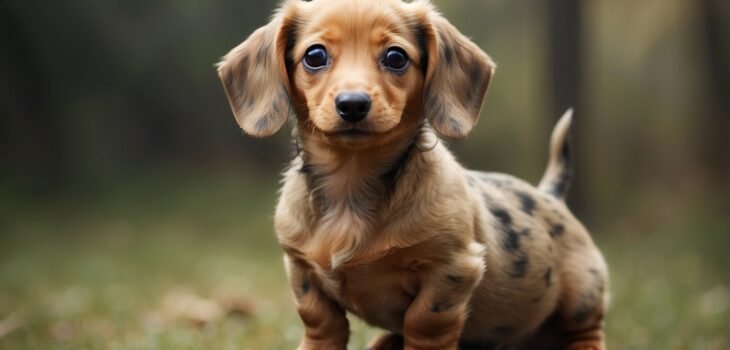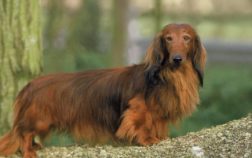Are you curious about how big a mini dachshund will get? Look no further! In this article, we will provide you with all the essential information you need to know about the size of a mini dachshund. Whether you already own one or are considering getting one, understanding their size potential is crucial. From their average height and weight to tips on how to manage their growth, we’ve got you covered. So, let’s explore the world of mini dachshunds together!
Physical Characteristics
Height
Mini Dachshunds typically have a height ranging from 5 to 7 inches at the shoulder. Their compact size gives them a distinct appearance that is both cute and charming. Despite their small stature, they are known for their confidence and spirited personality.
Weight
Miniature Dachshunds generally weigh between 8 and 11 pounds. This weight range is ideal to maintain their proportionate look and ensure their agility. It’s important to note that obesity can be a concern for Dachshunds, so keeping them within a healthy weight range is crucial for their overall well-being.
Body Shape
One of the defining features of a Mini Dachshund is their elongated body, which is built low to the ground. They have a deep chest and a sturdy bone structure. Their long back and muscular legs enable them to move swiftly and with agility. It’s worth noting that their unique body shape puts them at a higher risk for certain health issues, such as intervertebral disc disease, so proper care and attention to their physical condition is essential.

Growth and Development
Puppy Stage
During the puppy stage, Mini Dachshunds experience rapid growth. From the time they are born until they reach around six months, they go through significant changes in size and development. It is important to provide them with a balanced diet and proper veterinary care during this crucial stage to ensure healthy growth and development.
Adolescent Stage
As Mini Dachshunds transition into adolescence, they continue to grow and develop both physically and mentally. This is the stage where their body size and shape become more apparent. Regular exercise and a nutritious diet are vital during this stage to support their growth while maintaining a healthy weight.
Adult Stage
By the time Mini Dachshunds reach their adult stage, usually around one year old, their growth has typically stabilized. They have reached their full height and weight potential, and their body shape has become more defined. It is important to continue providing them with appropriate nutrition, exercise, and veterinary care to ensure their overall well-being throughout their adult life.
Breeding Standards
Federation Cynologique Internationale (FCI)
The FCI is an international organization that sets standards for dog breeds, including Mini Dachshunds. They have established guidelines for height, weight, and other physical characteristics that must be met for a Mini Dachshund to conform to the breed standard.

American Kennel Club (AKC)
The AKC is the main governing body for purebred dogs in the United States. They also have specific standards for Mini Dachshunds, which focus on height, weight, and proper body proportions. Mini Dachshunds that meet these standards are eligible for AKC registration and participation in conformation shows.
Other Breed Standards
In addition to the FCI and AKC standards, there are other organizations around the world that have established guidelines for Mini Dachshunds. These standards may vary slightly in terms of specific measurements and physical traits, but they generally emphasize maintaining the breed’s unique characteristics and overall functionality.
Factors Affecting Size
Genetics
Genetics play a significant role in determining the size of a Mini Dachshund. The size of their parents and previous generations can influence the size of the offspring. Responsible breeders carefully select breeding pairs to ensure that desirable size traits are passed down to future generations while maintaining the integrity of the breed.
Health and Nutrition
Proper health and nutrition are crucial factors in determining the size of a Mini Dachshund. A balanced diet that provides all necessary nutrients in the right proportions ensures healthy growth. Overfeeding can lead to excessive weight gain, while underfeeding can result in stunted growth. Regular veterinary check-ups and a well-balanced diet are essential for maintaining optimal size and overall health.
Exercise and Activity
Regular exercise and physical activity are important for maintaining a healthy weight and promoting optimal growth in Mini Dachshunds. Engaging in activities that are appropriate for their size, such as daily walks and interactive playtime, helps to keep their muscles strong and their weight in check. It’s important to strike a balance between exercise and rest, as overexertion can lead to injuries, especially considering their elongated spine.
Miniature vs Standard Dachshunds
Size Comparison
The most obvious difference between Miniature and Standard Dachshunds is their size. Mini Dachshunds are significantly smaller, with a height range of 5 to 7 inches at the shoulder, compared to the Standard Dachshunds who typically stand at 8 to 9 inches tall. However, both sizes share similarities in terms of body shape and overall appearance.
Temperament Differences
While Miniature and Standard Dachshunds share many personality traits, some differences can be observed. Mini Dachshunds are often described as lively, energetic, and brave, while Standard Dachshunds are known for being more independent and reserved. However, it is important to remember that individual temperament can vary and should not be solely determined by size.
Suitability for Different Lifestyles
Mini Dachshunds, due to their smaller size, are well-suited for individuals or families with limited living space, such as apartments or smaller houses. They also require less exercise compared to their Standard counterparts, making them an excellent choice for those with a more sedentary lifestyle. Standard Dachshunds, on the other hand, may thrive in homes with larger yards and more active lifestyles.
Size Variations
Size Range of Mini Dachshunds
Mini Dachshunds can vary slightly in size within the established height parameters. Some individuals may be smaller, closer to the lower end of the range, while others may be slightly taller and closer to the upper end of the range. However, it’s important to note that any significant deviation from the breed standard could indicate a potential health issue.
Teacup Dachshunds
While there is no official “teacup” classification for Dachshunds, some breeders may use this term to refer to exceptionally small individuals. However, it’s crucial to approach such claims with caution, as breeding for extremely small size can lead to various health problems. Responsible breeders prioritize the health and well-being of their dogs over creating excessively small or “teacup” Dachshunds.
Overweight and Underweight Concerns
Both overweight and underweight can be concerning for Mini Dachshunds. Obesity increases the risk of various health issues, including joint problems and diabetes. On the other hand, underweight Dachshunds may lack the necessary muscle mass and energy to lead a healthy and active life. Maintaining a healthy weight through a balanced diet and regular exercise is essential for their overall well-being.
Measuring Size
Measuring Height
To measure the height of a Mini Dachshund, use a measuring tape and measure from the ground to the highest point of their shoulder. Make sure the Dachshund is standing on all fours and is not slouching or stretching.
Measuring Length
Measuring the length of a Mini Dachshund is done by measuring from the base of their neck to the base of their tail. Keep in mind that their elongated body shape makes them unique, so it’s important to consider this factor when determining their overall size.
Measuring Weight
The weight of a Mini Dachshund can be measured using a reliable scale. Ensure that the scale is properly calibrated and measure the weight of the Dachshund while keeping their body position as steady as possible.
Interpreting Size Standards
Healthy vs Unhealthy Size
A healthy size for a Mini Dachshund falls within the established height and weight range. Deviations from these standards, either by being significantly smaller or larger, can indicate potential health issues. It’s important to consult with a veterinarian if there are concerns about a Mini Dachshund’s size to rule out any underlying health conditions.
Ideal Size for Show Dogs
For Mini Dachshunds participating in conformation shows, adhering to the breed standard is essential. Judges assess various physical attributes, including size, to determine the best representation of the breed. Mini Dachshunds that closely match the established size standards have a better chance of succeeding in conformation shows.
Ideal Size for Companion Pets
When it comes to choosing a Mini Dachshund as a companion pet, the ideal size is subjective and dependent on individual preferences and lifestyle. As long as the Mini Dachshund falls within the established size range and is in good health, it can make a wonderful and affectionate companion regardless of size.
Caring for a Mini Dachshund
Feeding
Proper nutrition is essential for the overall well-being and maintenance of a healthy weight for Mini Dachshunds. Feeding them a balanced diet that is appropriate for their age, weight, and activity level is crucial. It’s recommended to consult with a veterinarian to establish a feeding routine and ensure the right nutritional needs are met.
Exercise and Activity
While Mini Dachshunds may require less exercise compared to their Standard counterparts, they still need regular physical activity to maintain a healthy weight and prevent boredom. Daily walks, interactive playtime, and mental stimulation activities are essential to keep them physically and mentally stimulated.
Grooming
Grooming needs for Mini Dachshunds are relatively low maintenance. Regular brushing helps to keep their short, smooth coat in good condition. Additionally, their nails should be trimmed regularly to prevent overgrowth, and their ears checked for cleanliness to prevent ear infections. Dental care is also important to maintain good oral hygiene.
Conclusion
Understanding the size of Mini Dachshunds is key to responsible ownership and ensuring their overall well-being. Their height, weight, and body shape are defined by breed standards established by organizations like the FCI and AKC. It’s crucial to consider factors such as genetics, health, and nutrition, as well as individual variations within the breed. By providing proper care, nutrition, and exercise, Mini Dachshunds can live healthy and fulfilling lives in a size that suits their individual needs. The size of a Mini Dachshund may vary, but their unwavering charm and affectionate nature remain constant.




